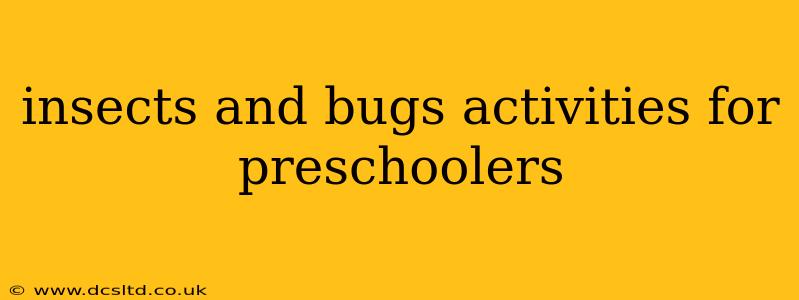Preschoolers are naturally curious about the world around them, and insects and bugs offer a fascinating realm for exploration and learning. These tiny creatures are readily accessible, sparking wonder and offering countless opportunities for hands-on activities that boost cognitive development, creativity, and fine motor skills. This guide provides engaging activities tailored for preschoolers, focusing on safety, fun, and educational value.
What are the Best Types of Insects for Preschoolers to Learn About?
Choosing the right insects for preschooler activities is crucial. Focus on common, non-threatening insects found in your local area. Ladybugs are a fantastic starting point; their bright colors and gentle nature make them ideal for observation. Butterflies, caterpillars, and ants are also excellent choices, offering opportunities to discuss life cycles and social structures. Avoid insects known to sting or bite, such as wasps or bees, unless you have proper safety precautions in place. Always supervise children closely during any insect-related activity.
How Can I Teach Preschoolers About Insects and Bugs Safely?
Safety is paramount when working with insects. Always emphasize gentle handling and respecting the creatures' habitats. Never force a child to interact with an insect if they are uncomfortable. Adult supervision is crucial at all times. Teach children to observe insects from a safe distance, using magnifying glasses to get a closer look. After handling any insect, always wash hands thoroughly. Furthermore, ensure that any collected insects are handled and returned to their environment responsibly. Avoid collecting insects that are endangered or protected in your area.
What are Some Fun and Engaging Insect-Themed Crafts?
Crafts are a great way to engage preschoolers' creativity and reinforce learning about insects. Here are some ideas:
- Ladybug Crafts: Use red and black paint, paper plates, or pom-poms to create adorable ladybugs. Children can add details like antennae and spots using various materials.
- Butterfly Wings: Cut out butterfly shapes from construction paper and let children decorate them with colorful markers, glitter, or tissue paper. They can then attach them to pipe cleaners to create movable wings.
- Ant Colony: Use brown construction paper to create an ant hill, and let children add individual ants using cut-out shapes or drawings. This activity can be expanded to discuss ant behavior and social structures.
- Insect Collages: Provide children with various natural materials like leaves, twigs, and seeds to create insect collages. They can use these materials to represent the body parts of different insects.
How Can I Create an Insect Habitat in My Classroom or Home?
Creating a temporary insect habitat is an excellent way for preschoolers to observe insects up close. A simple terrarium or bug hotel can provide a safe and enriching environment. Ensure the habitat is properly ventilated and provides the insects with appropriate food and moisture. Remember to release the insects back into their natural environment after observation. This process reinforces the importance of responsible interaction with nature.
What are Some Insect-Themed Games and Activities?
Beyond crafts and habitats, incorporate playful learning through games and activities:
- Insect Scavenger Hunt: Create a list of common insects or insect-related objects (like leaves or flowers) and have children search for them in your backyard or a nearby park.
- Insect Bingo: Create bingo cards with pictures of different insects and call out the names as children mark them on their cards.
- Insect Charades: Children act out different insects, and others guess what they are. This improves observational skills and creative expression.
- Storytelling: Encourage children to create their own insect stories. This enhances their language and imagination skills.
What are the Benefits of Insect-Themed Activities for Preschoolers?
Insect-themed activities provide numerous benefits for preschoolers:
- Develops scientific thinking: Children learn about different insect species, their habitats, and life cycles.
- Enhances fine motor skills: Crafts and other hands-on activities improve dexterity and hand-eye coordination.
- Fosters creativity: Making insect crafts and role-playing helps children express their imagination.
- Promotes observation skills: Close observation of insects develops attentiveness and detail-oriented thinking.
- Builds respect for nature: Children learn to appreciate and care for the environment and its inhabitants.
By implementing these engaging and educational activities, you can foster a love for nature and learning in your preschoolers while simultaneously improving their cognitive, creative, and fine motor skills. Remember, always prioritize safety and responsible interaction with the natural world.
